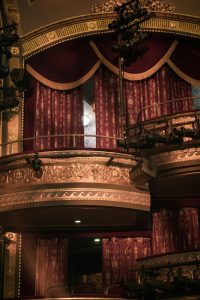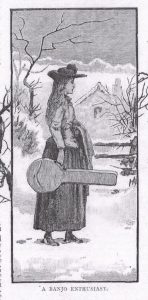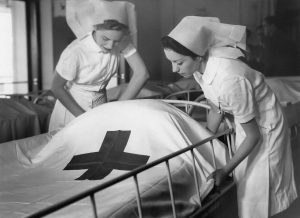Women Organists in Victorian Fiction
Part 2
Women had been serving as organists in England’s churches – though not in its cathedrals and royal and collegiate chapels – since the end of the eighteenth century, but their role was not entirely free of controversy. Husbands of two organists forbade their wives to play in church once they were married, and another woman organist was kept in her post despite numerous letters of complaint about her playing, perhaps because, as vestry minutes suggest, no one else was found to replace her. 12
Women occupied the benches of City of London churches early in the nineteenth century as well. But with the codification of woman’s role in Victorian society and of the role that music should play in their lives, the employment of women organists for church positions became a highly contentious issue. Correspondents to music journals questioned the propriety of women sharing space with God and men in church chancels and organ lofts, especially when the positions they might assume in organ playing were ‘extremely indelicate, if not indecent’. 13 Such claims, the Musical World suggested, masked the real reason for correspondents’ objections: Organists far outnumbered churches, and by eliminating women from competition, men would have a better chance of securing organist positions. 14
Yet women organists were in great demand in rural areas and in churches where no men could be had for the meagre salary offered, a fact confirmed in 1857 when the Church of England Quarterly Review commented that ‘Few churches now are without an organ, and the wives and sisters of the clergy form an excellent staff of organists, where there are no funds to procure professional help.’ 15
The situation had not changed by 1886 when The Girl’s Own Paper urged its readers with musical talent and leisure to qualify themselves as amateur organists for churches in agricultural and suburban parishes unable to pay for the services of a professional organist. 16 The theme was reinforced in several stories printed in the same magazine between 1880 and 1895 with amateur church organists as their heroines. 17
Conduct literature in the form of advice books helped define woman’s gendered role in British society. To Robert Shoemaker, periodicals probably were more influential than advice books in defining gender ideology during the period 1650 to 1850, ‘because they were less overtly prescriptive and were more widely read’. 18 Given that the novel has been called the fictional version of the conduct book, novels serialised in periodicals – and even short stories – could have the same influence on their readers. 19 Shoemaker notes that novels and periodicals largely portrayed women in domestic contexts, but that ‘women were increasingly portrayed as having the capacity and willpower to play a significant public role. Yet it was through the exercise of moral and domestic virtues that female characters exerted influence over the wider society’. 20
Addressing the role played by Victorian periodicals in the dissemination of gender ideologies, Hilary Fraser and her coauthors note that every periodical had its formal house style – its dominant discourse or voice – in which it presented the topics found within its pages. Influenced by the moral codes and mores of the time, this discourse both shaped and restrained, ‘much as women’s clothing of the period shaped and constrained their bodies’. 21 The voice of The Girl’s Own Paper was conservative, given its publisher The Religious Tract Society, an evangelical and anti-Catholic organization in sympathy with Anglican and nonconformist churches in England, as shown in the magazine’s portrayal of fictional women organists. 22
These women were all in their mid to late teens, except for Grace Erith, who, having taught as a music governess, may have been a bit older. All turned to work as a village church organist when in the straits of refined middle-class poverty brought on by a family member’s illness or old age. All of the heroines were amateur organists with varied musical training. Ivy Gardiner and Ritchie Marphell likely were taught by their fathers, and Beatrice Vaughan, by her uncle. May Goldworthy, who played both organ and harmonium, took lessons locally in her Welsh neighbourhood. Organ was not Grace’s primary instrument, and Nessie Cartright’s and Ellice Cresswell’s preparation for their organist positions is not known. But these women would have learned piano as an accomplishment in order to have the necessary keyboard skills. For most of these women organists the work was temporary but paid at least a nominal salary. May did not hold a regular church job but played for services when requested. Nessie later was offered and apparently accepted a permanent organist post until, like the other heroines, marriage ended her monetary hardship.
Filial duty, not music, was the underlying theme in these stories, and romance was more prominent than organ playing in their plots. We are told little about the music these organists played, for example, though we know that Ivy played the same music as her father with equal skill, that May played Mendelssohn’s Wedding March, that Ellice played a symphony of Beethoven, that Grace played an air of Handel’s and that Nessie played the ‘Noel! Noel!’ All would have played hymns as well.
Each heroine’s situation offered an object lesson in life that reinforced middle-class Victorian values. When in financial need, women should earn money by suitable work rather than accept charity, however well intended. An an organist position undertaken to the glory of God and for the benefit of one’s neighbourhood was an honourable occupation for women in these circumstances. Ivy also took on her father’s pupils, but likely on piano, not on organ, and May taught voice lessons for a short time. But marriage took priority over musical talent in most cases and would shift wage earning appropriately onto the husband so that the wife no longer had cause for remunerative employment.
Away from the world of fiction, The Girl’s Own Paper promoted amateur organ playing among its readers by offering articles on how to play the organ and the harmonium; reviewing organ music in its ‘Notices of New Music’; and including organ pieces among the music scores, mostly for piano and voice, in its weekly issues. In his article, John Stainer, then organist at Saint Paul’s Cathedral and a professor at the National Training School for Music, admitted that ‘There is something very fascinating in listening to the rich tones of a fine church organ, and probably there are but few girls who have not, at some time or other, longed to know how to perform on this “king of instruments.”’ He then guided the magazine’s readers through the perils of reaching an imaginary organ loft in order to introduce them to the technicalities of playing the organ. Stainer’s advice was supportive: ‘The answer to the question, “How am I to play the organ?” might be answered in two words, namely, “do it”. This is, in fact, the only answer that can be given.’ 23 That Stainer’s older sister Ann was an organist likely influenced his thinking on the matter. In an equally technical article, King Hall urged readers disheartened by the difficulties of learning to play the harmonium to persevere. 24
The magazine’s organists were aided in their selection of repertoire by reviews of works for organ and by printed music for harmonium or American organ, both home instruments, included in its pages. Perhaps with amateur church organists in mind, reviews assessed pieces’ level of difficulty and usefulness as voluntaries. Ten short pieces printed in The Girl’s Own Paper between 1888 and 1898 were composed for harmonium or American organ, for manuals only – no pedals – and would not have overtaxed the keyboard skills of an accomplished player. With titles such as ‘Elegy’, ‘Meditation’, ‘March’, and ‘Supplication’, the music likely was performed in the home. Only two titles, ‘Chorale’ and ‘Prelude’, suggested use in church.
That The Girl’s Own Paper had organists among its readers is evident from the Answers to Correspondents column in each issue. Only answers, not questions, were printed, but readers apparently asked for advice about transferring keyboard skills from piano to organ, selecting organ primers and repertoire and obtaining organ lessons. Other correspondents may have been concerned about potential health hazards associated with playing the organ, which suggests that the ongoing debate about women’s physical fitness for higher education and gainful employment had repercussions in the field of music as well. Between 1881 and 1894, correspondents Irene, Cecil Burn, Rob Roy and Lady Organist were all told that organ pedaling would put strain on the back and could cause physical injury. The activity looked strenuous, but the magazine’s answer must not have satisfied its readers, who continued to ask the same question.
In 1896 on a page of ‘Replies to Often-asked Questions’, the magazine’s answer to ‘Is Organ-playing bad for Girls?’ reflected a change for the better in its thinking on the matter: ‘Organ playing is not injurious to either sex, indeed it is a healthy though fatiguing occupation. It exercises the muscles of the hands and renders them delicate and precise. The movements of the legs in working the pedals are natural ones, being almost identical to those of walking.’ 26
If one may use fiction in The Girl’s Own Paper, as well as the nonfiction articles and Answers to Correspondents found in the magazine, as reflective of contemporary thinking, the musical messages conveyed to readers were mixed. It was fine for a young woman of talent to learn to play the organ and to practice on large instruments in church lofts. But to perform on these same instruments was another matter. Their organ playing was linked with small parish churches – presumably with smaller instruments – where their services were needed to fill the gap between professional men, and this is an important point. Although a public space, the church was a staunchly patriarchal institution, hence differing little from a woman’s private home environment in that regard. Likewise, all church organists were expected to defer to the clergy in matters of music – in fact, some churchwardens preferred women organists because of their tractability – again reinforcing the pater familias. 27
Although the number of women church organists in Victorian England can be numbered not by the handful but by the hundreds, only one of them was mentioned by name in the pages of The Girl’s Own Paper. In 1895, in a serialised article on ‘The Girl’s Outlook; or, What Is There to Talk About?’, the life of Elizabeth Stirling, an organ recitalist, church musician and composer who had died earlier that year after a professional career spanning over forty years, was a topic of discussion among three female friends. 27
Readers of the magazine were not expected to set their sights too high, that is, to aspire to professional status as an organist where only an amateur was expected. As one author explained, one’s gift for music ‘need not be of the highest order, as even a small portion of the gift can be improved with care, and fostered into usefulness’. 28 Their choice of instrument might take them outside the spatial parameters within which a woman’s music making normally took place, but this was not to be considered free license for women organists to transcend the societal parameters that applied to their music making, no matter where it occurred – they were not to usurp the traditionally male privilege of serving as a church’s organist. This message was subtly, yet consistently reinforced in The Girl’s Own Paper, which included organists among its readers, in fictional stories, in factual articles and in Answers to Correspondents.
I close with an example from one of these organists. In 1891, Annie FIndburgh asked the editor of The Girl’s Own Paper what was the ‘usual salary for an organist’. She was told that salary, which could range from £29 upwards, was based not on the amount of work done, but rather on the wealth and generosity of a congregation or parish, and in answer to what must have been another question, was told: ‘We never heard of a home being supplied.’ The editor continued: ‘You have formed very grand ideas about the worth of such an appointment.’ 29 Perhaps the editor’s admonishment was, on a different level, an apt commentary on the worth of those female organists who, with some notable exceptions, desired more than Victorian society was willing to accede to them. Should they be unclear about their assigned place on or off the organ bench, England’s women organists needed only turn to the stories they would find in The Girl’s Own Paper and follow the examples set by their fictional counterparts – Grace, Ivy, Ritchie, Beatrice, Madeline, May, Nessie and Ellice – from whom they would learn that usefulness without usurpation was the key to their employment as organists in Victorian England.
For Part 1, see the Blog posted on 20 June 2021.
Notes
12 ‘List of Marriages for the Year 1753’, Gentleman’s Magazine o.s. 23 (1753): 248; Herbert F.B. Compston, The Magdalen Hospital: The Story of a Great Charity (London: Society for Promoting Christian Knowledge, 1917), 163; Saint Andrew Undershaft London Vestry Minutes Commencing 1759 to 1807, Guildhall Library, MS 4118/3, 177–285.
13 Pedal, ‘No Lady Need Apply’, Musical World 35 (12 Sep 1857): 585.
14 ‘Really, some of our organists’, Musical World 35 (12 Sep 1857): 588.
15 ‘Church Music’, Church of England Quarterly Review, n.s., no. 14 (1857): 465.
16 Victoria Grosvenor, ‘The Amateur Church Organist’, The Girl’s Own Paper 8 (2 Oct 1886): 4–5.
17 Stories serialised in The Girl’s Own Paper: Anne Beale, ‘Queen o’ the May’, 2 (1880 – 81): 9 Oct–2 May; idem, ‘May Goldworthy’, 3 (1881–82): 1–29 Jul; Eglanton Thorne [Emily Elizabeth Charlton], ‘Midst Granite Hills’, 12 (1890–91): 1–29 Aug; A. Mabel Culverwell, ‘Music Hath Charms’, 12 (1890 – 91): 6–20 Dec; ‘The Organist’s Daughter’, 14 (1892 – 93): 4 – 18 Mar; Ada M. Trotter, ‘Marsh Marigolds’, 16 (1894–95): 6 Oct–23 Mar; Grace Stebbing, ‘Noël’, ‘Christmas Roses’ Extra Christmas Number, 1881, 17–23; M.M. Pollard, ‘The Organist’s Niece’, ‘Snowdrifts’ Extra Christmas Number, 1884, 3–12; Louisa E. Dobree, ‘Acquired Abroad’, ‘Snowdrifts’ Extra Christmas Number, 1884, 56–58.
18 Robert Shoemaker, Gender in English Society, 1650–1850 (London and New York: Longman, 1998), 310–11.
19 Ibid., 36.
20 Ibid., 310–11.
21 Hilary Fraser, Stephanie Green and Judith Johnston, Gender and the Victorian Periodical (Cambridge: Cambridge University Press, 2003), 79, 90, 82.
22 Joseph McAleer, Popular Reading and Publishing in Britain 1914–1950 (Oxford: Clarendon, 1992), 206.
23 John Stainer, ‘How to Play the Organ’, The Girl’s Own Paper 1 (22 May 1880): 328.
24 King Hall, ‘How to Play the Harmonium’, The Girl’s Own Paper 1 (24 Jul 1880): 328.
25 ‘Replies to Often-asked Questions’, The Girl’s Own Paper 17 (9 May 1896): 512.
26 A Metropolitan Churchwarden, ‘No Lady Need Apply’, Musical World 35 (1857): 585.
30 James and Nanette Mason, ‘The Girl’s Outlook; or, What Is There to Talk About?’ The Girl’s Own Paper 16 (29 Jun 1895): 610–11.
31 Grosvenor, ‘The Amateur Church Organist’, 4.
29 Answers to Correspondents: ‘Annie FIndburgh’, The Girl’s Own Paper 13 (3 Oct 1891): 16.



